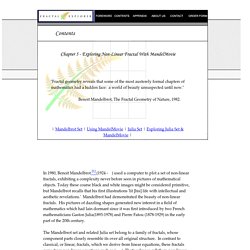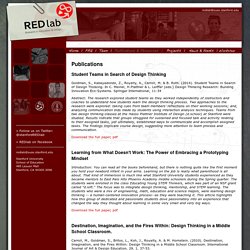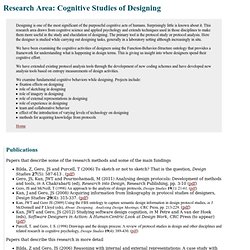

Chapter 5: Exploring Non-Linear Fractals with MandelMovie™ "Fractal geometry reveals that some of the most austerely formal chapters of mathematics had a hidden face: a world of beauty unsuspected until now.

" Benoit Mandelbrot, The Fractal Geometry of Nature, 1982. | Mandelbrot Set | Using MandelMovie | Julia Set | Exploring Julia Set & MandelMovie | In 1980, Benoit Mandelbrot [1] (1924 - ) used a computer to plot a set of non-linear fractals, exhibiting a complexity never before seen in pictures of mathematical objects. Today these coarse black and white images might be considered primitive, but Mandelbrot recalls that his first illustrations 'lit [his] life with intellectual and aesthetic revelations.' Mandelbrot had demonstrated the beauty of non-linear fractals. The Mandelbrot set and related Julia set belong to a family of fractals, whose component parts closely resemble its over all original structure. ). The Mandelbrot Set (top) "The stunning beauty of the images it generates means that its appeal is both emotional and universal. ... Chapter 4: Calculating Fractal Dimensions. Fractal Explorer - Contents.
A prime example of this adaptation is illustrated in the Eiffel Tower built in 1889.

Gustave Eiffel and his engineers purposely incorporated an interwoven design of steel girders supported by a continuing lattice of smaller trusses and beams into his structure, a structure that incorporates self-similarity to make effective use of material and minimize weight Figure 2.3 The Eiffel Tower Seen at Three Levels of Magnification. Initially this new branch of mathematics was thought to comprise shapes independent of the physical world, breaking free from the constraints of nature. Armed with irregular shapes, as if to shout out "See this is not all mathematics has to offer", early pioneers explored structures that Euclidean geometry could only describe as "pathological" or "gallery of monsters".
Karl Weierstrass and Helge von Koch discussed curves without tangents, Georg Cantor demonstrated segments without length, and Giuseppe Peano described a line that made area. Fractal Explorer - Contents. Figure 1.1 A collage of fractals.

Did you know that flowers, trees, lightning, cliffs and clouds all have fractal structures? In fact, it is hard to look around and not see something that exhibits a fractal pattern. Fractal shapes are not new; their repetitive patterns have always been with us. What is new is our awareness of them. It's as if we have opened our eyes for the first time to see that the world is full of rich textures and patterns. -Benoit Mandelbrot's opening to The Fractal Geometry of Nature, 1982 Figure 1.2 Johannes Kepler’s 1597 version of an Euclidean based solar system. Let's use FractaSketch to look at a the self-similar structure of a tree. Figure 1.6 FractaSketch ‘Nature’ folder. Chapter 3: Creating Classical Fractals on the Macintosh. "Every revolution was first a thought in one man's mind.

" - Ralph Waldo Emerson, 1870 | FractaSketch | Cantor Set | Peano Curve | Hilbert Curve | Koch Curve | Pascal Triangle | Dragon Curve | Finite Segments | Long before the word “fractal” was ever put down on paper or even spoken, its form was taking shape in the minds of revolutionary mathematicians. These revolutionaries looked beyond the world described by Euclid's geometry--a world confined to blocks, cones and spheres built from straight lines, flat planes and circles. They looked instead to the greater world of nature--a world that uses texture, branching and cracks to define its numerous complex objects.
Figure 3.1 Basic Linear Fractals. Weierstrass, Cantor, Pioncare, Peano, Hilbert, Koch, Sierpinski, and Hausdorff were mathematicians, who envisioned mathematical shapes that defied conventional descriptions. OpenStreetMap. REDlab- Research in Education & Design. Student Teams in Search of Design Thinking Goldman, S., Kabayadondo, Z., Royalty, A., Carroll, M.

& B. Roth. (2014). Professor John S. Gero. Designing is one of the most significant of the purposeful cognitive acts of humans.

Surprisingly little is known about it. This research area draws from cognitive science and applied psychology and extends techniques used in those disciplines to make them more useful in the study and elucidation of designing. The primary tool is the protocol study or protocol analysis. Here the designer is studied while carrying out designing tasks, generally in a laboratory setting although increasingly in situ. We have been examining the cognitive activities of designers using the Function-Behavior-Structure ontology that provides a framework for understanding what is happening in design terms.
We have extended existing protocol analysis tools through the development of new coding schemes and have developed new analysis tools based on entropy measurements of design activities. We examine fundamental cognitive behaviors while designing. Home. Performativeplaces : stanislav roudavski. AvaxHome. AAAARG DOESN'T EXIST. Biblio.com: Search Used Books, Textbooks, Rare Books, & Out of Print Books from Independent Booksellers. Free shipping worldwide on all books from The Book Depository. Log. 8 October 2018, dusan “Today, predicting the impact of human activities on the earth’s climate hinges on tracking interactions among phenomena of radically different dimensions, from the molecular to the planetary.

Climate in Motion shows that this multiscalar, multicausal framework emerged well before computers and satellites. Extending the history of modern climate science back into the nineteenth century, Deborah R. Coen uncovers its roots in the politics of empire-building in central and eastern Europe. Edward Shanken. AbeBooks Official Site - New & Used Books, New & Used Textbooks, Rare & Out of Print Books.